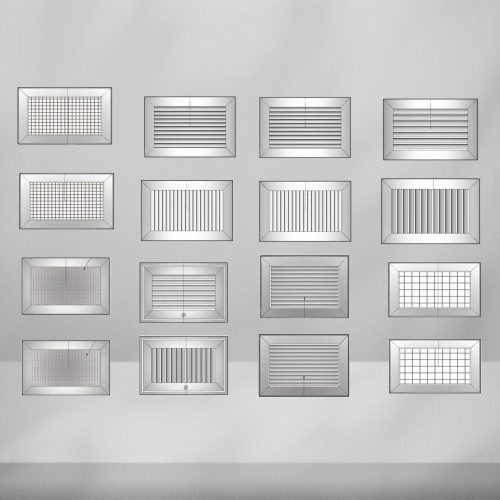Return Grilles And Registers

Dania Air Return grilles and registers are essential components of a building’s heating, ventilation, and air conditioning (HVAC) system. They play a crucial role in the circulation and distribution of heated or cooled air throughout a building. Here are some product details and key information about return grilles and registers:
-
Function:
- Return Grilles: These are installed in walls, ceilings, or floors and are designed to allow air to return to the HVAC system. They don’t have a damper and are solely meant for air return.
- Registers: Registers, on the other hand, not only act as an inlet for return air but also have adjustable dampers that allow the regulation or control of airflow. They are often installed in walls, floors, or ceilings and have a grille attached to them for both aesthetics and airflow management.
-
Design and Construction:
- Materials: Return grilles and registers can be constructed from various materials such as aluminum, steel, brass, or plastic, depending on the intended use, durability requirements, and aesthetic preferences.
- Finishes: They come in different finishes like brushed, polished, painted, or powder-coated to match different interior designs or architectural styles.
-
Types:
- Fixed Blade Grilles/Registers: These have stationary blades and provide a fixed airflow pattern.
- Adjustable Blade Grilles/Registers: These allow users to adjust the direction and volume of airflow by moving the blades.
- Filter Grilles/Registers: Some registers have a filter attached behind the grille, helping to filter the incoming air before it reaches the HVAC system.
-
Sizes and Shapes:
- They come in various sizes and shapes to accommodate different airflows and installation needs, ranging from small sizes for residential applications to larger sizes for commercial buildings.
-
Installation:
- Both return grilles and registers are typically installed during the construction phase or as replacements in existing systems. Proper installation is essential to ensure efficient airflow and system performance.
-
Maintenance:
- Regular cleaning and maintenance are necessary to prevent dust, debris, or blockages that can hinder airflow and reduce the system’s efficiency.
-
Noise Control:
- Some grilles and registers are designed with features to minimize noise, such as dampening materials or specialized designs that reduce air turbulence.
When choosing return grilles and registers, it’s crucial to consider factors like the size of the space, required airflow, aesthetic preferences, and any specific features needed for optimal HVAC system performance. Consulting with HVAC professionals or referring to manufacturer specifications can help in selecting the most suitable products for a particular application.
